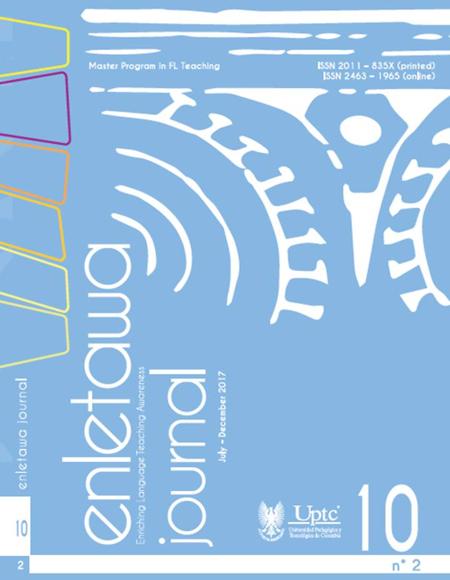Aesop's fables adaptation: an alternative for fostering values, oral production and listening comprehension

Abstract
This article aims at presenting the experiences acquired from the project titled “Aesop’s Fables Adaptation: An Alternative for Fostering Values, Oral Production and Listening Comprehension”, carried out at a public school in Tunja with fourth graders. The project related to the adaptation of Aesop´s fables, which were included in the school´s curriculum topics and implemented through different workshops. This was done in order to develop values awareness and English skills. Throughout this project, most of the students participated, were very attentive class after class, and enjoyed the activities. The students began to use the vocabulary they learnt from the fables for communicative purposes. In the same way, students were aware of moral aspects, the implicit values in each story, and the fables’ importance in their own lives
Keywords
Fables, Values, Reading Strategies, story adaptation, materials design
References
Blackham, J. (2013). The Fable as Literature. London: Bloomsbury Academic Collections.
Brown, D. (2007). Teaching by Principles. An interactive approach to Language Pedagogy. USA: Pearson Education.
Castro, A., and Nader, M. (2006). La Evaluación De Los Valores Humanos Con El Portrait Values Questionnaire De Schwartz. Interdisciplinaria. (23) 2,155-174.
Cook, V. (2016). Second Language Learning and Language Teaching. Retrieved from https://books.google.com.co/ books?id= QskeDAAAQBAJ&printsec=frontcover&dq=second+language+acquisition+cook&hl
Curtis, A., and O´ Hagan, M. (2009). Care and Education in Early Childhood. A student´s guide to theory and practice. New York: Routledge
Edwards, M. (2012). Literacy Practices: Using Literacies for Learning in Further Education Framework to Analyze Literacy Practices on a Post Compulsory Education and Training Teacher Education Programe. Student Engagement and Experience Journal, 1 (2), 1-10 .Sheffield Hallam University Research Archive (SHURA). Retrieved from https://research.shu.ac.uk/seej /index.php /seej /article/download /31/ edwards.
Ellis, G., and Brewster, J. (2014). Tell it Again, the Storytelling Handbook for Primary English Teachers. England: British Council.
Fraser, B. J., (2012). Classroom Environment. Canada: Routledge.
Li, M. P., and Lam, B. H. Cooperative Learning. A class, the active classroom. The Hong Kong Institute of Education. [Online resource] 2013. Retrieved from http://www.eduhk.hk/aclass/Theories/cooperativelearningcoursewriting_LBH%2024June.pdf
Library of Congress. (1919). The Aesop for Children with Original Pictures by Milo Winter. Retrieved from http:// read.gov/aesop/001.html
Ministerio de Educación Nacional. (2014). Colección Semilla: Libro para Sembrar y Cosechar Bibliotecas Escolares. Bogotá: Serie Río de Letras.
Téllez, M., and Núñez, A. (2009). ELT Materials: The Key to Fostering Effective Teaching and Learning Settings. Bdigital, 11 (2), 171-186.
Tomlinson, B. (1998). Materials development in language teaching. England: Cambridge University Press.
Winslow, R. (2012). What is reading comprehension? Enzine Articles. Retrieved from: http://ezinearticles. Com/?What-Is-Reading-Comprehension?&id=7014589.
Zarate, J. (2003). El arte de la relación maestro alumno en el proceso enseñanzaaprendizaje. México: Instituto Politécnico Nacional.